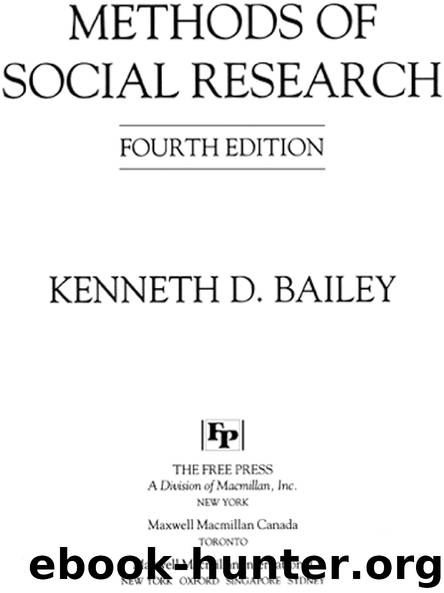Methods of Social Research by Kenneth D. Bailey

Author:Kenneth D. Bailey
Language: eng
Format: epub
Publisher: FREE PRESS
Published: 1994-07-15T00:00:00+00:00
SM’s statement is a formulation that explicates JH’s statement by telling what JH is really doing when he utters that particular sentence (i.e., telling persons to leave).
In addition to the practice of formulating, ethnomethodologists have studied other ways in which rules are followed to make the conversation meaningful and clear to the participants. Among topics studied are the sequencing of conversations, the manner in which conversations are terminated and the specification of general rules by which conversations are conducted. For example, Sacks, Schegloff, and Jefferson (1974) studied turn-taking in conversations. They found, among other rules, that turn-allocation techniques are used, and that repair mechanisms are available for dealing with turn-taking errors.
The findings most interesting to me resulted from Schegloff and Sacks’s (1973) work on ways in which conversations are terminated. They note that conversations normally consist of a series of turn-taking operations in which first one person, then another, speaks. If a speaker wishes to terminate the conversation he or she must somehow break the sequence. That is, he or she must take a turn at speaking, but must not continue to improve on or add additional useful information to the topic being discussed. He or she must terminate discussion of the current topic without initiating a new topic. Thus one must in essence “pass” on one’s opportunity to speak by indicating that one has nothing new to say, often by uttering some “preclosing” word or phrase. This phrase will pass the turn to the next speaker, who is not compelled to terminate, but it will provide a clue that the other speaker is ready to terminate. Preclosings noted by Schegloff and Sacks include “well” (“we-ell”), “OK,” and “so” (“so-oo”). Another common one is “anyway,” which is often preceded by “well” (“well, anyway”), or drawn out with the emphasis on the first syllable (“ANYway”). There are numerous other preclosings, such as “I’ve got to go now” (but often this too may be preceded by “well” and responded to with “OK”) or the familiar “We are costing you too much money” that is often heard on long-distance telephone calls. As with adherence to other rules we have noted in this chapter, the speaker is probably often not aware that he or she is even following a rule in closing.
Before I read the ethnomethodologists’ research reports, I was aware that I closed conversations, but not that there was any consistency in the way I did it, or that I said any particular words to occasion such termination. After I read about preclosings I noted that I nearly always closed with “well” or “OK” without thinking about it, and that others did the same.
There has recently been a substantial amount of interest in conversational analysis. Atkinson and Heritage (1984) report a number of studies of conversational analysis, including conversation and body movements, laughter, and audience response to public speaking. Maynard (1985) reported on the function of social conflict among children. He analyzed children’s conversations, with emphasis on the manifest functions of conflict. Molotch
Download
This site does not store any files on its server. We only index and link to content provided by other sites. Please contact the content providers to delete copyright contents if any and email us, we'll remove relevant links or contents immediately.
Talking to Strangers by Malcolm Gladwell(13281)
The Compound Effect by Darren Hardy(8866)
Tools of Titans by Timothy Ferriss(8298)
Wonder by R. J. Palacio(8047)
The Lover by Duras Marguerite(7855)
A Court of Wings and Ruin by Sarah J. Maas(7723)
The Circle by Dave Eggers(7061)
Deep Work by Cal Newport(6953)
Kaplan MCAT General Chemistry Review by Kaplan(6895)
To All the Boys I've Loved Before by Jenny Han(5802)
Wiseguy by Nicholas Pileggi(5699)
The Body: A Guide for Occupants by Bill Bryson(5023)
Eat That Frog! by Brian Tracy(4477)
1,001 ASVAB Practice Questions For Dummies by Powers Rod(4469)
Cracking the GRE Premium Edition with 6 Practice Tests, 2015 (Graduate School Test Preparation) by Princeton Review(4245)
Pre-Suasion: A Revolutionary Way to Influence and Persuade by Robert Cialdini(4182)
Barron's AP Biology by Goldberg M.S. Deborah T(4120)
ACT Math For Dummies by Zegarelli Mark(4014)
Alive: The Story of the Andes Survivors by Piers Paul Read(3994)
